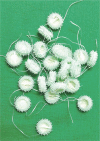Comparative Evaluation of Plaque Removal Effectiveness of Manual and Chewable Toothbrushes in Children: A Randomized Clinical Trial
- PMID: 31571781
- PMCID: PMC6749879
- DOI: 10.5005/jp-journals-10005-1604
Comparative Evaluation of Plaque Removal Effectiveness of Manual and Chewable Toothbrushes in Children: A Randomized Clinical Trial
Abstract
Objective: In children, manual dexterity poses a problem with the use of manual tooth brushes (MB), resulting in inefficient plaque removal. Recently, novel chewable brushes (CB) have been introduced which could overcome this problem but are less researched in children. The objective of this study is to assess and compare the plaque removal effectiveness of CB with that of MB.
Materials and methods: A total of 60 patients aged 8 to 10 years were enrolled in a single-blinded randomized clinical trial. At baseline, disclosing solution was applied and the Turesky modification of the Quigley-Hein index (TQHI) plaque index and Loe and Silness gingival index were recorded. The subjects were randomly divided into two groups as group I (MB) and group II (CB) and they were instructed to use their respective brushes for a period of 1 week. For statistical comparison, the difference (prebrushing minus postbrushing) in average scores was calculated. Data were evaluated by the independent t test and paired t test, with p < 0.05.
Results: The overall plaque scores reduced from 1.71 ± 0.4 to 0.79 ± 0.24 when using CB and from 1.64 ± 0.64 to 1.13 ± 0.47 when using MBs. On lingual tooth surfaces, CB showed a plaque reduction of 38.70 ± 11.04 to 12.60 ± 4.79 compared to less reduction from 37.43 ± 14.26 to 28.73 ± 11.37 for MB. The overall gingival scores were also reduced from 0.33 ± 0.51 to 0.09 ± 0.07 when using CB and from 0.30 ± 0.33 to 0.19 ± 0.23 when using MB. Differences in scores between the two brushes were statistically significant (p = 0.0001).
Conclusion: It was concluded that the experimental CB was able to remove a significant amount of plaque, particularly on the lingual surfaces, and reduced gingival index scores, thereby improving oral hygiene and gingival health status.
How to cite this article: Kayalvizhi G, Radha S, et al. Comparative Evaluation of Plaque Removal Effectiveness of Manual and Chewable Toothbrushes in Children: A Randomized Clinical Trial. Int J Clin Pediatr Dent 2019;12(2):107-110.
Keywords: Chewable; Dental plaque index; Gingivitis; Oral health; Oral hygiene; Randomized clinical trial.
Copyright © 2019; Jaypee Brothers Medical Publishers (P) Ltd.
Conflict of interest statement
Source of support: Nil Conflict of interest: None
Figures
References
-
- Malekafzali B, Biria M, et al. Plaque removal by manual and electric toothbrushing among children. EMHJ. 2011;17(2):115–120. - PubMed
-
- Bezgin T, Dag C, et al. How effective is a chewable brush in removing plaque in children? A pilot study. J Pediatr Dent. 2015;3:41–45. doi: 10.4103/2321-6646.155557. DOI: - DOI
-
- Silverman J, Rosivack G, et al. Comparison of Powered and Manual Toothbrushes for Plaque Removal by 4- to 5-year-old Children. Pediatr Dent. 2004;26:225–230. - PubMed
LinkOut - more resources
Full Text Sources
Miscellaneous

